As the use of AI content grows, there are more and more questions about the ownership and rights of this type of content. The Get A Copywriter team conducted an extensive investigation into this matter to answer the most common questions and find out if there’s a safe way to use AI writing tools.
But what exactly is AI content? Get an overview of what this type of writing is and how it works.
Why ownership of content is important
Under general copyright law, creative content (whether that’s written content, images, video, or other types of content) is considered to be the intellectual property of the person who created it.
However, when a business hires an agency or freelancer to create content, both parties will usually sign an agreement giving the business the rights to the content they purchased. Similarly, if an in-house writer creates content for a company, the business owns all of the rights to that content, not the writer.
Being clear about content ownership when you’re running a business is vital. If you don’t own the rights to your content, then you can’t use it legally. If you publish content you don’t own the rights to, the copyright owner could take legal action against you.
Content ownership definition
A content owner is a person or company who has the exclusive right to use, reproduce, modify, and distribute creative content. This also includes any derivatives of that content.
Content ownership is different from copyright. Copyright is a legal protection given to creators of original works, which grants them certain rights. On the other hand, content ownership is an agreement between two parties (typically the creator and the buyer) that establishes who has the right to use a certain piece of content.
Understanding content ownership
Content ownership has become a hot topic in recent years due to the rise in popularity of social media and content-sharing platforms like Medium.
The rules around content ownership are complicated by these platforms. If you created the content, you own the copyright: that much is certain. But if you post your content on platforms like Medium, does the platform own it? Can other people repost or use your content without permission?
And if you use a tool or software to help you create that content, the situation becomes even more complicated. Who owns the content you’ve created with AI — you or the software provider?
Ownership rights of digital content
When it comes to digital content ownership, there are a few factors that need to be taken into consideration:
- Who created the content — Are you the original creator? If not, did you purchase the rights to use it?
- Who is hosting the content — If you’re using a content-sharing platform or social media platform, then they may own certain elements of the content that you post.
- Are you using software or tools to create your content? — If so, who owns the copyright on any content generated with these tools?
Ownership rights of website content
If you host content on a website, then you typically own all of the rights to that content. This includes any text, images, videos, and other elements.
However, if you use third-party services (such as web hosting companies or content management systems) to host your website, then they may have some ownership over certain parts of your website’s content.
It’s important to check the terms and conditions of any third-party services you use to fully understand the ownership rights of any content you host on your website.
Ownership rights of social media content
When it comes to social media content, ownership rights can be more complicated.
Each social media platform has terms and conditions you agree to when you create an account, and these usually state that the platform has some ownership rights to the content you post.
This means that while you do own the copyright to your content, the platform may have certain rights over it as well. Social media platform like Facebook, Twitter, and Instagram do not claim ownership of your content. But, by using them, you grant them a license to use, copy, and distribute that content. In some cases, they can even sell the license to third parties.
AI vs. AI and writer vs. professional writers:
the ultimate comparison
Explore the key features of all approaches to writing content
and find out what works better for your business.
Your email is safe with us
AI data ownership: issues and concerns
AI-generated content is a relatively new topic, and the rules surrounding ownership are still being worked out.
EU and US copyright laws currently do not allow for copyrighting content created by AI. This is because a content creator has to be human or a “legal personality” (a person with legal rights on behalf of a company). As AI content is created by an algorithm, it doesn’t fit either of these criteria. Australian copyright law will also only grant copyright to literary or artistic works “made by a human author.”
However, this rule only applies if the content is created solely by AI. Once this content is changed with human editing, it can be copyrightable — and the human editor (or the company they work for) would become the owner of the content.
There are also ethical concerns around ownership of data generated by AI tools. AI algorithms often use data from a variety of sources that may be owned or copyrighted by others. As such, it may be classed as a derivative work. But, without knowing the source, it would be impossible to credit the original owners.
AI content writing risks
There are still a lot of murky waters when it comes to AI content writing and copyright. As a content creator or publisher, it’s important to be aware of the risks involved with using AI-generated content in your own work.
- Firstly, there’s always the risk that someone else could claim ownership rights over the content you create with AI. This means that if you unintentionally plagiarize someone else’s work, you may be liable for copyright infringement.
- As you’re using third-party AI services, you may be subject to their terms and conditions. This means that they could own the rights to any content you create with their AI tools.
- Most AI tools available today are known for their tendency to “hallucinate” or state incorrect information as facts. This means there is a high risk of publishing inaccurate content if you leave AI-generated content unchecked.
- Finally, in order to claim copyright on your AI content, you must be able to prove that it was created with “substantial human input.” If you don’t have evidence to support this, you may not be able to protect your content from being copied and used by others.
Determining ownership of AI-generated content
So who does own AI content? Ultimately, it’s down to the terms and conditions of the platform you’re using.
Ask ChatGPT who owns the content it generates and it will tell you something like: “As an AI language model, I do not have any ownership over the content that I generate.” That doesn’t really explain much, but the OpenAI terms of use state that they will not claim copyright over any content created with their API.
Jasper’s terms and conditions are less clear, although the CEO has confirmed that they also give up all rights to AI content generated by their platform.
It’s important to note that there’s nothing stopping any AI platform from changing its terms and conditions at any time. So make sure you read the fine print before you sign up, and stay aware of any changes that might affect your ownership rights.
And with all that being said, there’s always a possibility that the content you create with AI is not unique. If AI creates the same piece of content for two users, who will own the copyright? There have also been cases of AI tools copying content word for word from other sources, so there’s no guarantee that you can claim ownership without substantial editing.
Is your content really yours?
In conclusion, AI-generated content is still a relatively new and uncharted area when it comes to ownership, intellectual property rights, and copyright law.
There’s no denying the advantages that AI offers. For some simple copywriting tasks like writing short descriptions, AI can do a good enough job if used in combination with a human editor. This is an easy way to solve the problems related to ownership, copy accuracy, and uniqueness while still benefiting from the speed and convenience of AI.
While the legal complexities are still being ironed out, there’s only one way to make sure that your content is really yours: either write it yourself or hire a human copywriter to create it or edit it for you and give you full rights to the content.
AI+Human from Get A Copywriter
Empower your content with Intelligence
and be sure it’s fine for SEO
Do you want to take advantage of the benefits of AI-generated content? Not all tools are created equal. Find out how to choose the best AI content generation tools for your needs and how best to use them.
But what exactly is AI content and what advantages does it offer? Understand the technology behind AI-generated content and how you can make it work for you.
Are AI copywriting tools worth using?
If you work in any aspect of digital marketing or online publishing, you can’t have missed the hype surrounding ChatGPT, Jasper, and other AI copywriting tools.
These AI writing assistants promise to save time, money, and effort by generating content ideas and even complete pieces of copy. But are they really worth using? Or do the risks outweigh the advantages?
AI vs. AI and writer vs. professional writers:
the ultimate comparison
Explore the key features of all approaches to writing content
and find out what works better for your business.
Your email is safe with us
The quick answer is that it depends on how you use these tools and what you’re trying to achieve. If you’re hoping that AI will take over the entire process of content generation so you can fire your writing team, you’re going to be disappointed. AI is not a replacement for human copywriters.
However, artificial intelligence does work well as an assistant to a human writer. It can be a fantastic tool for helping the creative process and suggesting direction for content ideas and structure.
You can also use AI to speed up content production by creating content outlines, generating headline ideas, and writing meta descriptions and short pieces of copy.
In this article, we’ll look at some of the most popular AI copywriting and content creation tools available today.
The best AI copywriting tools
There are new AI copywriting tools appearing every day. Some of them can be very useful, while you may want to avoid others. Here are a few of the top-rated AI content writing tools you might want to consider:
Jasper

Jasper (formerly known as Jarvis) made headlines when it became one of the first AI tools to hit “unicorn” status, meaning it was valued at over $1 billion.
While Jasper now includes a chatbot similar to ChatGPT, its main interface is a freeform text editor that takes commands written in plain English and writes paragraphs of copy based on the instructions it’s given.
Jasper also comes with several content templates to assist in producing different types of copy, such as product descriptions, social media posts, and blog articles.
Jasper features
- Templates based on popular copywriting frameworks such as AIDA
- A one-shot blog post template that will generate an entire blog post with an introduction, body, and conclusion
- Option to specify the tone of voice, such as “friendly” or “informative,” or even a specific person such as “Joe Rogan”
- “Boss mode” feature that allows for long-form content creation in an editor similar to Google Docs
- Chrome extension that enables you to use Jasper anywhere you write on the web
- Built-in integration with Surfer SEO
- Supports over 29 languages (although the official word is it’s trained more “thoroughly” in English)
Pricing
Jasper pricing is based on the number of words you generate each month, with plans starting from $49 a month for 50,000 words.
Pros and cons of Jasper for AI copywriting
Pros
|
Cons
|
Writesonic
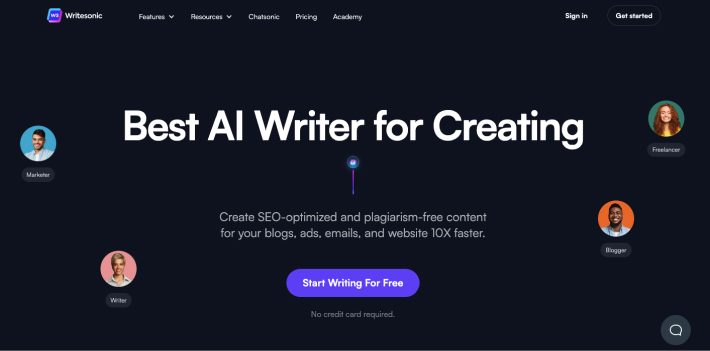
Writesonic is an easy-to-use AI copywriting tool designed to make content creation faster and more efficient. Aimed at marketers, small business owners, and website publishers, it gives users the ability to generate entire pieces of content at the click of a button.
The template-based interface allows users to quickly produce content such as landing pages, CTAs, Amazon product descriptions, and blog posts. It also includes specific templates to generate content for social media platforms including Twitter, LinkedIn, Instagram, and TikTok.
Writesonic features
- Large library of templates designed to help you create content for specific business and marketing purposes such as a social media content plan or company mission
- Paraphrasing tool for rewriting content
- Quickly generate ideas for blog content and articles
- Surfer SEO integration
- Trained on copy from some of the world’s top brands (unfortunately, the company doesn’t specify which brands!)
Pricing
Somewhat uniquely, Writesonic allows you to adjust the quality of the content produced from “economy” to “premium” and pricing changes accordingly. Content generated at economy level is generally simpler and similar to what you might expect from a non-native writer, while premium content is more creative and uses a wider vocabulary. Plans start from $12.67 a month for 19,000 words at the premium level and 190,000 words at the economy level.
Pros and cons of Writesonic for AI copywriting
Pros
|
Cons
|
Copy.ai

Copy.ai markets itself as a tool to overcome writer’s block, with promises to help writers write blog posts 10x faster and assist business owners in crafting more compelling copy.
The tool is designed mainly for writing blog posts, emails, and social media posts, and it’s very easy to get started with a step-by-step wizard that asks for details about your brand and products before spitting out a selection of auto-generated content.
Copy.ai is very clear that the copy you generate with the tool is not intended to be published as is, and you should rather use it as a starting point to edit, refine, and expand upon.
Copy.ai features
- Specific templates for different types of content, such as listicles, how-to blogs, and email nurture sequences
- AI workflow automation to speed up content production
- Creates copy designed to be optimized for high conversions
- Social media caption and description generator for all the major platforms
Pricing
Copy.ai offers a free plan that allows you to generate up to 2,000 words a month. Paid plans start at $36 a month. The major benefit of Copy.ai over its competitors is that the pro plans offer unlimited words, so you can generate as much content as you wish without having to pay extra for it.
Pros and cons of Copy.ai for AI copywriting
Pros
|
Cons
|
The best AI tools to rewrite content
There are many reasons why you might want to rewrite content, from simply wanting to redraft a piece of copy in a more engaging way to replicating an entire blog post while ensuring it’s not at risk of duplicate content penalties.
Most AI tools offer some sort of paraphrasing feature to help you quickly redraft content and make it undetectable by tools like Copyscape. However, publishing someone else’s content that you’ve rewritten is ethically problematic, even if it can’t currently be detected by an automated tool. If you choose to use this kind of content on your website, it’s possible the copyright owner of the original content could take legal action. Google also takes a dim view of this practice, so you may be at risk of search engine penalties if they’re able to detect it at some point in the future.
The main benefits of using one of these tools are that the AI can understand sentence structure, so the result should be readable (unlike the article spinners of the early days of SEO), and it’s much faster than manually copyediting a piece of content. But because of the issues previously mentioned, it’s best to stick to rewording your own content.
Wordtune
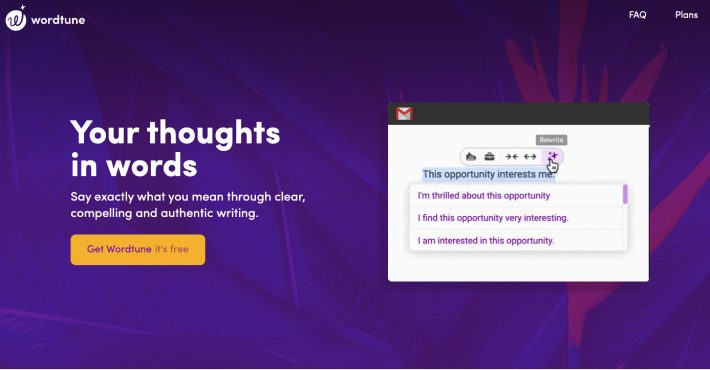
While Wordtune can also create content from scratch, its main focus is to help you quickly rewrite pieces of existing copy as unique content with varying options to lengthen or shorten the copy or give it a new tone of voice.
Wordtune also comes with a Chrome extension for summarizing long-form text, which will take the main points from a blog post, academic paper, or report and produce a short summary. This can be a very useful tool for speeding up research and helping you to understand complex topics.
Features
- Add “spices” to your text by adding a joke, fact, or analogy to make it more engaging
- Includes Chrome extension to find synonyms for words you write in emails, social media, and other places on the web
- Rewrite function makes content original to avoid plagiarism
- Summarize long text and YouTube videos
Pricing
Wordtune offers a free plan, which allows you to rewrite 10 short pieces of copy a day. Premium plans start from $9.99 a month with unlimited rewrites of whole paragraphs and all the features.
Pros and cons of Wordtune for rewriting content
Pros
|
Cons
|
QuillBot
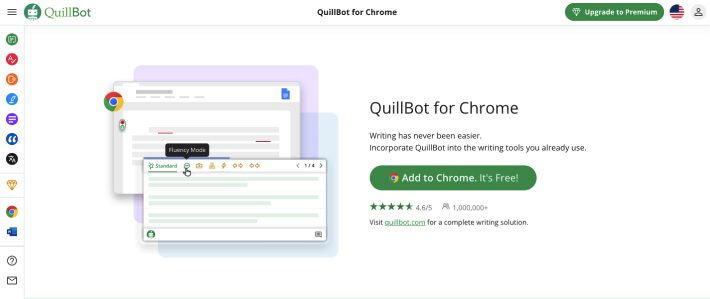
QuillBot is an AI-powered paraphrasing tool that helps you quickly rewrite content to improve grammar and fluency, change the tone of the text, or add more creative ideas.
The tool also includes a plagiarism checker, which will identify any duplicate content and suggest ways to rewrite it or instantly add an accurate citation.
Features
- Translate between over 100 languages
- Summarize text into key sentences
- Generate citations from web pages, journal articles, or books
- Expand, shorten, or improve text in several ways
- Check for grammar errors and plagiarism all in one tool
Pricing
There’s a free version of QuillBot with limited functionality. The premium version includes the plagiarism checker and can paraphrase unlimited text and summarize up to 600 words. Plans start from $8.33 a month.
Pros and cons of QuillBot for rewriting content
Pros
|
Cons
|
WordAi
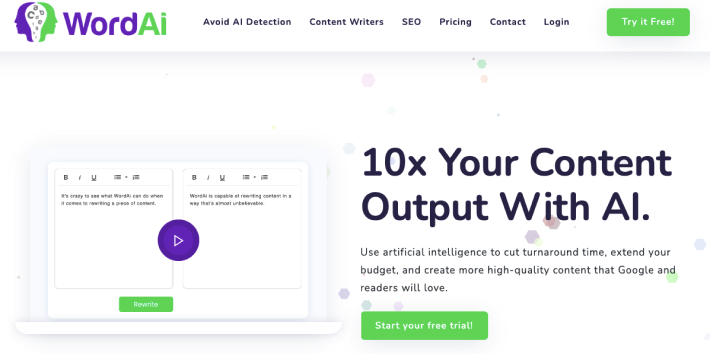
WordAi is a content rewriter that uses AI to restructure sentences, simplify copy into shorter sentences, fix incorrect spelling and grammar, and optimize web content by adding LSI keywords.
The tool also claims to avoid detection by humanizing content so it won’t be flagged as being generated by AI (we’ve not tested these claims).
Features
- Bulk rewrite content
- Each article can be rewritten up to 1,000 times
- Integration with Article Forge to import articles directly
- Improve the quality and clarity of poorly written text
Pricing
WordAi plans start from $27 a month.
Pros and cons of WordAi for rewriting content
Pros
|
Cons
|
The best AI content detection tools
If you choose to use AI-generated content on your website, it’s important to be aware of the potential risks.
Google has stated that automated content generation can be seen as a form of spam and can lead to action being taken against your website, such as penalties or even getting deindexed from search results.
You should also keep in mind that you can’t copyright AI-generated content unless it’s been edited significantly by a human. So, if someone copies your AI-generated text, you won’t be able to take any legal action.
For these reasons, it’s important to run any content you produce through an AI detection tool to protect your brand and reputation.
Originality.AI
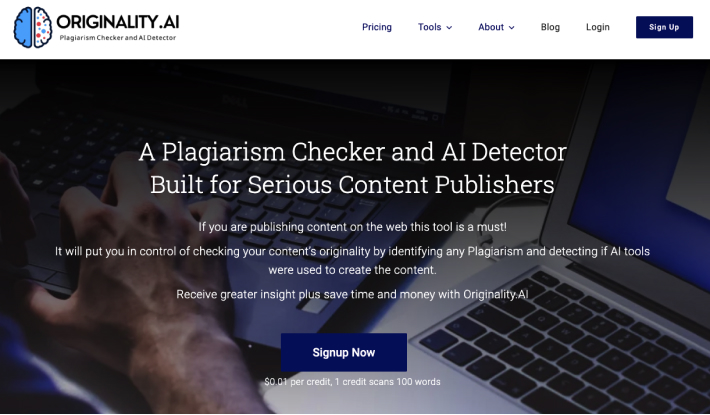
This tool was built with web publishers in mind, unlike other plagiarism detectors that are intended mainly for academic content. You can scan any type of document or web copy for duplicated text and AI-generated text at the touch of a button. The accuracy of Originality.AI has been measured at over 94%, depending on the tool that was used to create the content.
Pricing: $0.01 per credit, 1 credit scans 100 words
Pros and cons of Originality.AI for detecting AI-generated content
Pros
|
Cons
|
GPTZero

GPTZero claims to be “the world’s #1 AI detector” with over a million users. The tool will scan text you paste in and give you scores based on randomness and variation to give you an overall determination of whether it’s been created by a human or an AI. Sentences more likely to be written by AI are also highlighted.
Pricing: Free
Pros and cons of GPTZero for detecting AI-generated content
Pros
|
Cons
|
The best AI content idea generators
Perhaps one of the best use cases of AI when it comes to content creation is for idea generation. We’ve all had those times when we’re just stuck for ideas for the next blog post. And browsing the web for inspiration is time-consuming, not to mention the fact that everyone keeps publishing the same ideas over and over again.
You can use AI as a brainstorming assistant to generate new ideas in seconds. As well as blog post headlines, email subject lines, and ideas for social media campaigns, you can also use AI to generate new angles on the same topics.
ChatGPT

ChatGPT is probably the most well-known tool on this list and is responsible for transforming AI content generation from a niche concept to one that is now widely used.
Developed by the team at OpenAI, ChatGPT is essentially an advanced chatbot. Simply ask it a question or give it an instruction and it will generate content outlines, topic ideas, headlines, and even complete pieces of copy.
ChatGPT Features
- Conversational interface enables users to ask questions on almost any topic and carry out a convincing conversation; it remembers topics and can follow along with the conversation, like a human
- Text generation uses natural language processing to mimic content written by humans
- Ability to research and answer questions from its database
- Generate ideas for content quickly, including topics, headlines, and outlines
- Supports over 90 languages
Pricing
ChatGPT is currently in the beta phase and is free to use. OpenAI has recently announced the launch of ChatGPT Plus — a subscription plan that will cost $20 a month and give users better response times and more features.
Pros and cons of ChatGPT for generating content ideas
Pros
|
Cons
|
Surfer SEO

Surfer is a little bit different from most of the tools on this list, as it combines a keyword research tool with the power of AI to help you create content that’s more likely to rank and perform well.
Enter your primary keyword and the tool will analyze millions of pages to recommend new topic clusters and ideas for related content. It then uses AI to generate an outline of your post, including headings, keywords, and even whole paragraphs of text that you can add to your own content.
Surfer SEO features
- Research keyword opportunities to find hot topics and ideas for related content
- AI-powered article outline generator that creates a whole structure for your content
- Automated tips to improve SEO of every piece of content
- New article ideas delivered every week
- Integration with Jasper if you want more AI assistance with writing
- Built-in plagiarism detector
Pricing
From $49 a month for up to 2 websites, 240 page audits a year, and 120 articles a year, with unlimited keyword research and content ideas.
Pros and cons of Surfer SEO for generating content ideas
Pros
|
Cons
|
NeuralText

This is another tool that combines content optimization software with AI text generation to help you to come up with new ideas for content and improve the SEO of your web copy in a single platform.
NeuralText aims to improve on existing SEO tools by using the power of natural language processing to speed up the process of creating content for your website and improving the chance of it achieving a high ranking in Google and other search engines.
Features
- Keyword clustering tool to reduce time spent researching keywords and content ideas
- AI-powered SEO content brief generation
- Replaces manual competitor research
- Get relevant, real user questions sourced from Quora, Google Suggest, and other sources
- Automatically include statistics and data in content
- Generate content ideas, blog post titles, content hooks, slogans, and ideas for social media content in seconds
Pricing
From $19 a month for up to 20,000 words of AI-generated content and 2,000 keyword suggestions.
Pros and cons of NeuralText for generating content ideas
Pros
|
Cons
|
How to improve AI content generation using these tools
Using AI tools for content creation can be a great way to speed up the process and get more ideas and inspiration when you’re drawing a blank, but it’s important to remember that AI is no substitute for human intelligence and creativity.
Rather than relying on AI to do all the work, it’s best to use it as a writing aid instead of a content generator. Some of the new breeds of AI tools are very effective for content ideation and improving SEO without the risk of churning out low-quality, plagiarized content.
With careful use of these AI-powered tools, you’ll have access to an arsenal of features designed specifically for optimizing your web copy and creating high-quality content quickly. There’s no denying that AI offers many opportunities in today’s competitive digital marketplace. But never forget that there’s still no substitute for a skilled writer and that originality, creativity, and human expertise are all key ingredients for success.
AI+Human from Get A Copywriter
Empower your content with Intelligence
and be sure it’s fine for SEO